


The TRACE images may be used without restrictions
in publications of any kind. We
appreciate an acknowledgement indicating that
the Transition Region and Coronal Explorer, TRACE,
is a mission of the Stanford-Lockheed Institute for Space
Research, and part of the NASA Small Explorer program. More information on
TRACE and other TRACE images can be found
here.

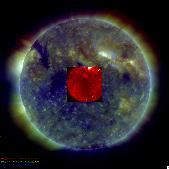 |
On Monday, June 21, 2010, at 23:57 UT, the Transition Region and
Coronal Explorer (TRACE) took its last science exposure after over
twelve successful years on orbit. The image to the left shows
the TRACE 171A exposure embedded in a nearly cotemporal SDO
AIA 211/193/171 composite of the full Sun.
The TRACE Small Explorer was a remarkably successful mission, with
over 1000 scientific publications to date based directly or indirectly
on its millions of images of the hot outermost atmosphere of the Sun.
Designed for an 8-month prime mission, the instrument continued to
function without significant flaws up to its last image. But its
capabilities have been overtaken by the state-of-the art Atmospheric
Imaging Assembly on the Solar Dynamics Observatory in all but the
sharpness of its images. Hence, after a few months of joint observing
to enable cross-calibration that allows SDO's AIA to build on a full
solar cycle of coronal observations, it was time to part with TRACE.
We thank NASA and the community for their lasting support. It has
been a privilege to be associated with all of the scientists who
contributed to TRACE's success; hopefully, the legacy that it leaves
in the TRACE resident archive (accessible through trace.lmsal.com, as
always) will continue to be a valuable asset in years to come.
 |
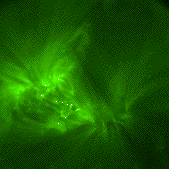 |
While TRACE was observing Active Region 11048 in its 195Å channel
(sensitive mostly to plasma emission around 1.5 MK), it observed a
filament destabilization just prior to 01 UT on 2010/02/18.
The filament is seen to rise, but it does not break through
the overlying field (in which case it would have resulted
in a coronal mass ejection from the Sun). Instead, the field
is seen to rise and unwind, and then settle in with the
restraining field around it. The
movie
shows the entire event, some five times more extended that the
diameter of the entire Earth, took only some 10 minutes for the field
to deform, and less than an hour for the loops to settle back to
a quiescent state.
Courtesy Adam Kobelski (MSU).
 |
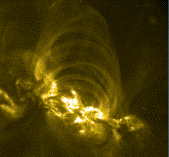 |
Just before and after a moderate C3.7 flare, observed by TRACE
on 2010/02/10 around 15 UT in its 195Å channel, coronal
loops could be seen to shift in a whirling motion. These were first
most clearly at the leading, western side. After the flare, more such
displacements were seen more towards the interior of the region.
This movie (3MB, QT/H264)
shows a 5 hour interval around the time of the flare and the loop
motions, which are reminiscent of motions expected near separatrices
in the magnetic field.
 |
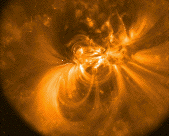 |
This image of Active Region 11039 was taken by TRACE in its
171Å channel on 2009/12/31 at 07:03UT. It shows the
moderately sized active region, one of the first sizable
regions of the new
sunspot cycle, surrounded by quiet Sun. The region was observed
continuously from 2009/12/29 through 2010/01/08 when it had vanished
entirely behind the disk. During this time, multiple eruptions
punctuated the gradual evolution of the corona as the region began
to decay and as it interacted with nearby smaller bipolar regions that
emerged and decayed (particularly to its north).
Image courtesy of Dawn Meyers (TRACE, at GSFC).
 |
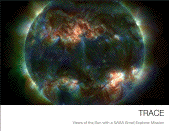 |
TRACE picture bookDownload a pdf (15MB) TRACE picture book with a collection of the best and unusual pictures from the TRACE image collection shown in these web pages.  |
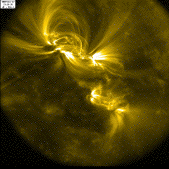 |
With the Sun's activity persistently low, 2009 was
not a good year for active-region observations. But
when tracking active region 11034, TRACE observed
another region as it was emerging onto the solar
surface. AR 11035 began to emerge on 2009/12/14,
and TRACE followed its evolution, and its interactions
with its neighbor AR 11034, from then on. This
(2x2 binned; 36 MB QT)
movie shows the evolution
over five days,
from 2009/12/12 12:49UT through 2009/12/17 16:54. the
image (left) shows the two neighboring regions on 2009/12/17 at
13:16UT; adjacent dark regions suggest coronal holes with fields
reaching into the heliosphere (consistent with our
PFSS model).
 |
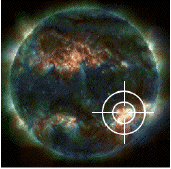 |
What TRACE observed: a visual target synopsis for the WL channelLooking for observations of active-region disk crossings, filaments on the limb, quiet Sun, the north pole, or coronal holes with TRACE? We have multiple summaries of observations on line [links below], but we now add a visual summary of the entire mission (periodically updated to the present): We have prepared a series of visual summaries of TRACE observations from the start of the mission to the present in the form of a series of movies. Each movie shows approximately 7 to 11 months of observations (depending on the frequency of WL observations), summarized in up to 24 frames per day (depending on the maximum number obtained each day), sampled uniformly from all available white-light (WL) images. The frames are shown on the position of the solar disk where TRACE was pointing at the time; they fade away with an e-folding time scale of approximately 2 days. The date and time of the observation are shown at the bottom of each frame. Each of the movies is approximately 85MB to 115MB in size, and plays in 2.4 minutes at 30 frames/sec.
Other summary information on TRACE observations can be found at:
 |
 |
This 42MB QuickTime movie,
taken by TRACE with its White-Light channel, shows three spot groups in
close proximity: a slowly-evolving pre-existing spot that sprouts
some pores, a moderately-large emerging flux region with pores and spots
that evolve rapidly, and a much smaller emerging flux regions with only
pores. The images span a period of 6 days, from 2001/08/09 to 2001/08/15.
 |
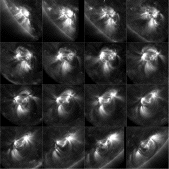 |
This composite image shows 16 snapshots of one of the first active regions
of Sunspot Cycle 24, AR 11026, observed by TRACE in its 171Å passband,
from 2009/09/23 04:11 UT through 2009/10/01 00:03 UT, i.e. over 8 days with
roughly 12h between the images in this set. Even though the region
evolved and aged over the 8-day period, the composite image gives a good
impression of the 3D structure of the field seen from different angles
as the solar rotation gave TRACE a changing perspective. Overall,
TRACE collected well over 3000 images of this region during its disk passage.
 |
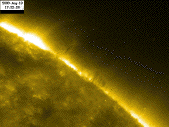 |
On 2009/08/18, TRACE observed a small filament configuration at the limb.
This
2h:20m (QuickTime) movie
(rocking back and forth) shows how dynamic these quiet-Sun structures
can be, with dark, near-vertical whisps of cool, chromospheric material
rocking back and forth with dynamics that is yet to be understood.
Courtesy of Aki Takeda (MSU).
 |
|
| Home | Mission | Instrument | Team | Operations | Results | Images | Movies | Education | Site Info. | |